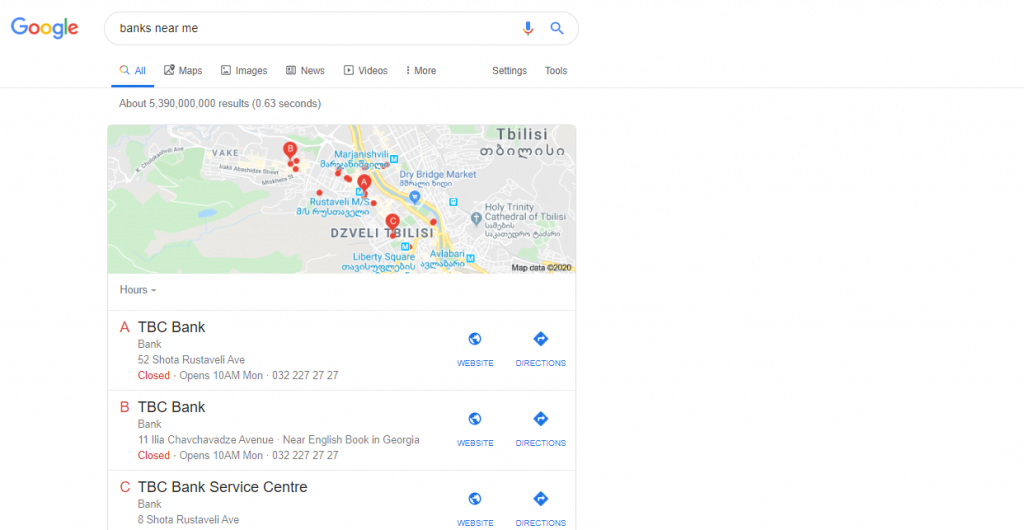How to Improve Search Performance for Banking Websites
To improve search performance for banking websites, you should invest your time and resources in SEO – Search Engine Optimization. SEO is the most effective tool to improve your website’s performance in search results. According to statistics, 93% of online experiences begin with a search engine. So most likely, most of your website visitors are going to land on your site from a search engine as well. An optimized website will help your website be more discoverable by users and will generate more traffic.
Briefly about SEO
Search Engine Optimization is a process of optimizing a website so it can perform better in specific search results. To find pages and content online, users use queries by typing words and phrases into the engine – those are called keywords. And search engines discover and arrange relevant results based on more than 200 factors. If your website appears in the results, it means your website ranks. To improve ranking, you need to optimize your website based on the ranking factors. Some of the ranking signals are not confirmed and are debatable when discussed between SEO experts, but there are some that Google has already confirmed and they definitely affect the way your website performs in search results.
The core idea behind optimization is that you make a user-friendly website designed for better user experience, while by different steps, you help the search engine understand your web page is relevant to users’ intention when searching. To find out more about SEO, click here to read beginners guide to SEO.
Page Speed
As we have mentioned above, there are ranking factors that Google has confirmed itself, and Page Speed is amongst them. Page Speed was confirmed by Google twice – in 2010 and 2018. When Google finds pages, it checks the page speed, and if the website is considerably slow, it won’t rank well in search results. The reason behind this is that users, even if they see your page in results and visit your site, are going to abandon it if it takes a long time to load. The percentage of users abandoning a website is called the bounce rate, and it increases when the load time is too long.
Per Google, as page load time goes:
- From 1 to 3 seconds the probability of bounce increases by 32%,
- 1 to 5 seconds the probability of bounce increases by 90%,
- 1 to 6 seconds the probability of bounce increases by 106%,
- 1 to 10 seconds the probability of bounce increases by 123%
To find out whether or not your website speed is the reason for users abandoning your website, click here.
Local SEO for Your Banking Website
The keyword “banks near me,” receives anywhere from 30.3 to 70.8 thousand Google searches per month. And 46% of all Google searches are looking for local information.
This means the vast majority of your website visitors are performing a local search and looking for a bank that is close to them. And when users search for local content, based on different factors, Google organizes results in a selection of results called a local pack. The local pack is a section in Google’s search results that shows local businesses – also referred to as Local 3-Pack since Google displays 3 best local results in a search. A user can hit “more results” to see more businesses on the list. For a demonstration, see the picture below.

The Google Local 3-pack appears in 93% of searches with local intent.
How to Rank for a Local Pack
To rank for the Local Pack, you should:
- Optimize Google My Business listing
- Create local content
- Get more reviews from customers.
- Increase Page Speed
- Make a mobile-friendly website
- Have a Contact Page on your website
- Have a clickable phone number
- Indicate the opening hours of your business
- Add photos
To get started, create a page on Google My Business.
“Getting on Google My Business can increase your chances of showing up in Google’s Local Pack, Local Finder, Google Maps, and organic rankings in general.” – According to MOZ.
Create Local Content
Local content is important to rank in local searches. It allows you to target desired keywords that are connected to the city and area you are located in. We understand that, as a bank, you probably have more than one branch, and those might be in different cities. In this scenario, you can create separate pages for each city. Having a blog is very beneficial to your local SEO. In the study from BrightLocal, 68% of respondents believe all local businesses need to have a blog, and 98% think businesses should update their blogs at least once a month.
If you are wondering what to write about, BrightLocal offers a list of topics for local businesses to write about:
- Help and ‘How To’ guides
- Local news / events
- Company news
- Product news and reviews
- Case studies
- Industry trends/predictions
- Industry news
- Results of studies or research
- Industry conference/events writeups
- National news
Reviews help customers decide whether or not to visit your business and they help you improve local search ranking. According to MOZ, review signals (review quantity, review velocity, review diversity) help you to rank in the local pack. To get reviews, ask your existing customers who visit your bank to review your business on Google. Invest your time in responding to each of them, so others see it’s worth their time to write about their experience with your company.
Page Speed is also crucial for your local SEO; people searching for businesses in the local area want the results as fast as possible. Google will take the speed of a page into account when choosing it for a local pack.
Making a mobile-friendly website should be among your top priorities, as Google uses a website’s mobile responsiveness as a ranking factor. Besides, 58% of people search for a local business on their smartphone daily.
It’s essential to have a contact page with the name of your business, the address, and the phone number to rank for the local pack. This information should match your contact details on your Google My Business profile.
Having a clickable phone number is something you should consider having to rank for the local pack. Users who search for businesses on Google, mostly end up calling the business. The statistics show that 76% of local searches result in a phone call. If you don’t have a clickable number, there are other businesses that do, and most likely, they will be the ones receiving a call. To make your number clickable, follow these steps from Google.
If you want your clients to visit your bank, you should be able to provide information about the opening hours. You don’t want anyone to walk to your business to find it closed. This kind of experience results in bad reviews and lower ratings. To find how to edit your opening hours, click here.
Photos demonstrate the way your business looks and helps your customers in decision-making – whether or not to visit your bank. It’s an important step in local SEO and helps to get more customers, as it increases the trustworthiness of your company. To add and manage photos, follow these steps.
Optimize for Voice Search
2020 is the year of voice search, as it is predicted that the percentage of voice searches out of all searches performed will hit 50%. For many users worldwide, voice search is becoming more convenient and fast. 52% of smartphone owners in the US report using voice assistants on their mobile devices. And 75% of smart-speaker owners search for local businesses on a weekly basis. If your goal is to rank better in local searches, then your strategy should definitely include optimizing for voice search.
Page Speed, as we already have discussed, is a crucial factor for voice search, too, so make sure to speed your site up for all kinds of searches.
How do people use voice search? Users speak to their device instead of typing a query, and the way they speak is close to the way they talk to a human being. Saying out loud some words without context feels unnatural, so users tend to use sentences when they speak to a device. Instead of saying “bank, ATM, USD,” they will ask “what is the nearest ATM I can use to withdraw USD.” When users use three or more words to find content, it’s called long-tail keywords. To optimize for voice search, you should target more long-tail keywords. Besides, there are LSI keywords – words associated with the main keywords and help Google understand the context of the page. Using LSI Keywords will help you rank for both voice and typed search queries.
According to SEMrush, words that you should target for voice search are question keywords like, “how,” “what,” “when,” “why,” and “where,” long-tail keywords that we have discussed above, and “filler words” that make queries conversational like “I, the, of the, on the, to, for,” etc. Additionally, don’t forget about local keywords and target queries that contain “near me,” “closest to,” “nearby,” “in the area,” etc.
Need Professional Help? Call Us Today!
If you need a new website, better functionality, increased security, or an online campaign to be created, call Internet Marketing Geeks for your banking website. Tell us your needs and let us help with you a solution that will work best for you!

